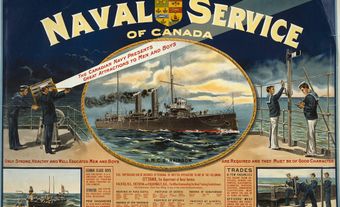The Oberon class was a highly successful British conventional submarine design, operated by the Royal Navy (RN) and exported widely to Commonwealth and allied navies. The Royal Canadian Navy (RCN) acquired three of the type in the mid-1960s to act as antisubmarine warfare (ASW) training “targets” for surface and air forces. A major operational update in the 1980s transformed them into true hunter-killer attack submarines and laid the groundwork for a proper submarine force with their replacement by the Victoria class at the turn of the 21st century.

The Oberon-Class
Canada did not operate submarines during the Second World War, although many Canadians served with distinction aboard them in the Royal Navy. This exchange practice continued into the postwar period. Although the RN commissioned the first of the Oberon-class in 1960, they were similar in concept, looks and general layout to those wartime “boats” (the colloquial naval term for submarines). The “O-boats” incorporated technology that had been copied and improved from captured German Type XXI U-boats — not unlike their Soviet counterparts, which constituted the bulk of that navy’s attack force into the 1970s. When the Canadian government decided to acquire submarines for ASW training purposes, the Oberons were a logical choice. (The RCN preferred the more expensive but more capable US Navy Barbel-class, but the federal government opted for the Oberons for economic reasons).
Did you know?
With the expected delivery of the three O-boats, the First Canadian Submarine Squadron (CANSUBRON ONE) was created in 1966. It eventually became known as the Canadian Submarine Force (CANSUBFOR) with the arrival of the Victoria-class submarines.
In the RN, all ships of a class have names starting with the same letter. The Canadian O-boats were named for Indigenous Peoples: HMC Ships Ojibwa (hull number 72), Onondaga (73) and Okanagan (74). All three were built in HM Royal Dockyard Chatham, Kent, Ojibwa having been laid down for the Royal Navy as Onyx and acquired mid-build. As such, she was commissioned in 1965, well ahead of the others (Onondaga in 1967 and Okanagan in 1968), but had to be retrofitted with several Canadian modifications. The most obvious difference was the placement of the galley: in Ojibwa, the galley was next to the engine room, while in Onondaga and Okanagan, it was placed ahead of the control room as part of the accommodation space (a more hospitable arrangement). All three had similar Canadian communications equipment, larger air conditioning units, a snorkel de-icer and were fitted with the United States Navy (USN) Mark-37 torpedo.
A fourth O-boat, ex-HMS Olympus, was acquired in 1989 as an alongside training vessel, and ex-HMS Osiris was acquired upon decommissioning from the RN in 1992 as a source of spare parts to keep the original three serviceable pending replacement.
Did you know?
A snorkel is a device that allows conventional submarines to “breathe” air for their diesel engines to recharge their batteries while submerged at periscope depth; this makes the submarine hard to detect by radar. The concept was first exploited on German U-boats as the “schnorkel” late in the Second World War. Commonwealth submariners refer to it as the “snort”.
Operational Update
In the late 1970s, the Canadian navy had an aging and outmoded surface fleet. One of its solutions was to upgrade the O-boats from simple training platforms into hunter-killer attack submarines. (This complemented upgrades of the St Laurent classes.) The Submarine Operational Update Program (SOUP) was approved in 1979 and completed in 1986, incorporating new communications, passive sonar and fire control systems. Additional improvements later in the decade included a towed-array sonar and the American heavy-weight Mk 48 torpedo. Although rather late in the Cold War and not openly acknowledged at the time, it is now known that the Canadian O-boats enjoyed some success tracking Soviet submarines in the North Atlantic.

Employment and Disposal
The O-boats spent most of their service based out of Halifax, Nova Scotia, to counter the presumed Soviet opponents. The only exception was a brief cruise by Ojibwa to the west coast in 1977 (in company with Athabaskan, also the first foray of an Iroquois-class destroyer to the Pacific coast). With the end of the Cold War, they ventured farther afield: in 1990, Okanagan became the first Canadian submarine to undertake a cruise on the Great Lakes, and Onondaga and Ojibwa made training deployments to the Pacific coast, respectively in 1994 and 1997. With the anticipated acceptance of the Victoria-class submarines, Onondaga was the last to be paid off, in Halifax on 28 July 2000.
Ojibwa is preserved as a museum ship in Port Burwell, Ontario, as is Onondaga at Rimouski, Quebec.

 Share on Facebook
Share on Facebook Share on X
Share on X Share by Email
Share by Email Share on Google Classroom
Share on Google Classroom

